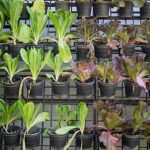Are you looking for creative ideas for vegetable gardens? Whether you have a small urban space or a large backyard, there are innovative ways to grow your own produce. From vertical gardening to unique vegetable varieties, this article will explore the benefits of having a vegetable garden and provide inspiration for getting creative with your gardening endeavors.
Having a vegetable garden offers numerous benefits, including access to fresh and healthy produce, cost savings, and the satisfaction of growing your own food. In this article, we will delve into various creative ideas for vegetable gardens that cater to different spaces and preferences. From container gardening to edible landscaping, there are plenty of ways to make the most out of your gardening experience.
We will also explore the concept of seasonal planting and companion planting as strategies for maximizing the yield of your vegetable garden. Additionally, we will discuss DIY garden projects that add both functionality and aesthetic appeal to your garden space. By the end of this article, you’ll be equipped with a host of innovative ideas for cultivating a thriving vegetable garden.
Small Space, Big Impact
With the increasing trend of urban living and limited outdoor space, many people have turned to creative ideas for vegetable gardens in small urban areas. Despite the challenges of space constraints, there are numerous innovative ways to grow a thriving vegetable garden in an urban setting. From container gardening to vertical gardening, there are plenty of options for urban dwellers to enjoy the benefits of growing their own fresh produce.
Container Gardening: Innovative Ways to Grow Vegetables in Limited Space
Container gardening is an excellent solution for those with limited outdoor space. Utilizing containers such as pots, planters, or even repurposed items like old barrels or buckets can allow urban gardeners to grow a variety of vegetables on patios, balconies, and rooftops. By selecting the right size and type of containers and providing proper soil, drainage, and sunlight, it is possible to enjoy a bountiful harvest even in a small space.
Vertical Gardening: Maximizing Space and Aesthetics in Vegetable Gardens
Another creative idea for vegetable gardens in urban areas is vertical gardening. This method involves growing plants upwards using trellises, wall-mounted planters, or stacked containers. By taking advantage of vertical space on walls or fences, urban gardeners can maximize their growing area while also adding visual interest and beauty to their outdoor spaces.
Companion Planting: How to Combine Vegetables for a Thriving Garden
In addition to utilizing creative methods for small spaces, urban gardeners can also benefit from implementing companion planting techniques. This involves planting combinations of vegetables that complement each other and provide natural pest control or nutrient enhancement. By strategically planning which vegetables to plant together based on their mutual benefits, urban gardeners can optimize their limited space for a successful and thriving vegetable garden experience.
Container Gardening
When it comes to vegetable gardening, limited space should never be a hindrance. With the right creative ideas and techniques, anyone can successfully grow their own vegetables even in the smallest of spaces. Container gardening is a popular and effective method for growing vegetables in limited areas such as balconies, patios, or even small yards. Here are some innovative ways to make the most out of container gardening for your vegetable garden:
- Vertical Planters: Utilize vertical space by using stackable planter pots or hanging baskets to grow a variety of vegetables such as tomatoes, peppers, and herbs.
- Repurposed Containers: Get creative by repurposing old items such as buckets, cans, or even old furniture into unique planters for your vegetables.
- Multi-Level Gardens: Create multiple levels of container gardens using shelves or stands to maximize space and create an appealing display of different vegetable varieties.
In addition to these creative ideas for container gardening, it’s important to consider the specific needs of each vegetable when choosing containers. Some vegetables may require deeper pots for root growth, while others may thrive in shallow containers. By carefully selecting the right containers and combining them with innovative planting ideas, you can enjoy a bountiful vegetable garden regardless of limited space.
In summary, container gardening offers endless possibilities for growing vegetables in limited spaces. With creativity and resourcefulness, anyone can turn small areas into thriving vegetable gardens. Whether you’re living in an apartment or have a tiny backyard, container gardening provides the opportunity to enjoy homegrown produce that is both fresh and sustainable. So don’t let limited space hold you back-get creative with container gardening and start growing your own vegetables today.
Vertical Gardening
When it comes to maximizing space in your vegetable garden, vertical gardening is the way to go. Not only does it allow you to make the most of limited space, but it also adds a visually appealing element to your garden. Here are some creative ideas for vertical gardening that will help you achieve both functionality and aesthetics:
- Vertical Planters: Utilize wall-mounted planters or hanging baskets to grow a variety of vegetables vertically. This not only saves space but also creates an eye-catching display in your garden.
- Trellises and Arbors: Incorporating trellises and arbors into your vegetable garden allows vining plants such as tomatoes, cucumbers, and peas to grow upward, freeing up ground space and adding height to your garden design.
- Vertical Hydroponic Systems: For those interested in hydroponic gardening, vertical systems are an innovative way to grow vegetables without soil. These systems can be freestanding or wall-mounted, providing a modern and efficient approach to vegetable cultivation.
In addition to the functional benefits of vertical gardening, there is also an aesthetic appeal that comes with utilizing vertical space in your vegetable garden. The use of trellises, arbors, and hanging planters can add depth and visual interest to your garden, turning it into a beautiful focal point for your outdoor space. With these creative ideas for vertical gardening, you can maximize space while adding a touch of visual flair to your vegetable garden.
Companion Planting
When it comes to vegetable gardening, companion planting is a strategy that involves planting different types of vegetables together to maximize their growth and overall health. This age-old gardening practice not only helps in pest control and pollination but also improves the flavor and yield of the crops. By strategically combining certain vegetables, gardeners can create a thriving garden that is both visually appealing and productive.
Benefits of Companion Planting
Companion planting offers numerous benefits for vegetable gardens. For instance, some plants release natural compounds into the soil that repel pests or inhibit the growth of harmful microorganisms, offering protection to neighboring vegetables. Additionally, certain combinations of plants can help attract beneficial insects like bees and butterflies, which are essential for pollination. Furthermore, companion planting can also optimize space in the garden by pairing plants with differing root depths or growth habits, allowing for efficient use of limited space.
Popular Combinations for Thriving Vegetable Gardens
One popular example of companion planting is the combination of tomatoes, basil, and onions. These three vegetables not only complement each other in flavor but also work together to repel common pests such as aphids and hornworms.
Another well-known combination is planting corn alongside pole beans and squash – a classic Native American trio known as the “three sisters.” This combination allows the corn to provide support for the beans to climb while the squash acts as ground cover to suppress weeds and retain moisture.
Considerations for Successful Companion Planting
When planning a companion planting scheme for your vegetable garden, it’s important to consider factors such as sunlight requirements, water needs, and compatibility between different vegetables. Some plants may compete with others for resources if not paired thoughtfully. Understanding the growing habits and characteristics of each vegetable is crucial in creating a harmonious environment where they can thrive together.
Overall, embracing companion planting in your vegetable garden can lead to healthier plants, improved yields, and reduced reliance on chemical pesticides. With thoughtful consideration and experimentation, you can discover creative combinations that work best for your unique growing conditions. So go ahead and get creative with your vegetable garden by exploring the endless possibilities of companion planting.
Seasonal Planting
When it comes to maintaining a bountiful vegetable garden throughout the year, strategic seasonal planting is key. By understanding the different growing seasons and the specific needs of each vegetable variety, you can ensure a continuous harvest from your garden. Here are some tips to help you make the most of seasonal planting in your vegetable garden.
First, it’s important to familiarize yourself with the growing seasons in your area. Different vegetables thrive in different seasons, so knowing when to plant specific crops is essential for a successful harvest. For example, cool-weather crops like lettuce, spinach, and kale are best planted in early spring or late summer, while warm-weather crops such as tomatoes, peppers, and cucumbers thrive in the heat of summer.
Another important aspect of seasonal planting is succession planting. This technique involves staggering the planting of certain crops at regular intervals to ensure a continuous supply of fresh produce throughout the season. For example, instead of planting an entire row of lettuce at once, you can sow new seeds every couple of weeks to have a steady and ongoing harvest.
In addition to understanding growing seasons and succession planting, rotating your crops is also crucial for maintaining soil health and preventing disease. Avoid planting the same type of vegetable in the same spot year after year as this can deplete the soil of essential nutrients and increase the risk of pests and diseases. Instead, practice crop rotation by moving plants around your garden beds each season.
This not only promotes better soil fertility but also reduces the likelihood of pest infestations. By implementing these tips for seasonal planting into your vegetable garden plan, you can enjoy a constant supply of fresh produce throughout the year.
| Benefit | Example |
|---|---|
| Succession Planting | Sowing new seeds every couple of weeks for ongoing harvest |
| Crop Rotation | Moving plants around garden beds each season to promote soil fertility |
Edible Landscaping
When it comes to vegetable gardening, many people think of planting rows of crops in a separate, designated area. However, one creative idea for vegetable gardens that is gaining popularity is edible landscaping. This concept involves seamlessly integrating vegetables into your overall garden design, blending both beauty and function. By incorporating vegetables into your flower beds, borders, or even as part of your front yard landscaping, you can create a visually stunning and productive space.
One strategy for edible landscaping is to use vegetables with attractive foliage or colorful fruits as ornamental features. For example, Swiss chard and kale have vibrant leaves that can add texture and interest to your garden. Additionally, plants like purple basil or rainbow-colored carrots can bring a pop of color to your landscape. By strategically placing these vegetables among flowers and other ornamental plants, you can create an aesthetically pleasing display that also provides a harvest of fresh produce.
Another approach to edible landscaping is to use vegetables as border plants or groundcover. Low-growing herbs such as thyme and oregano can be used to edge flower beds, providing a practical and aromatic addition to your garden design.
In larger areas, spreading varieties of vegetables like trailing squash or strawberries can be used as groundcover to fill in spaces while producing food at the same time. This not only maximizes the use of space but also creates visual interest with varying textures and colors.
Overall, integrating vegetables into your overall garden design through edible landscaping offers a unique way to combine aesthetics with functionality. This creative idea for vegetable gardens allows you to enjoy the beauty of your landscape while reaping the rewards of growing fresh produce right at home. Whether adding pops of color with vibrant foliage or using veggies as groundcover, edible landscaping provides endless opportunities for creating a bountiful and visually appealing garden space.
Unique Vegetable Varieties
When it comes to vegetable gardening, most people think of the usual tomatoes, lettuce, carrots, and peppers. But there is a whole world of unique and uncommon vegetables that you can grow in your garden to add variety and interest to your harvest.
One example of a unique vegetable variety is the purple cauliflower. This stunning vegetable not only adds a pop of color to your garden but also contains the same nutrients found in regular white cauliflower. Another interesting option is the Romanesco broccoli, with its fractal-shaped heads that are as beautiful as they are delicious.
In addition to these unusual varieties, consider exploring specialty vegetables such as black radishes, watermelon radishes, or rainbow-colored Swiss chard. These vegetables not only taste great but can also be visually appealing additions to your garden. By incorporating these unique vegetable varieties into your garden, you can expand your culinary horizons and impress friends and family with your diverse harvest.
| Unique Vegetable Variety | Description |
|---|---|
| Purple Cauliflower | This stunning vegetable adds a pop of color to your garden and is packed with nutrients. |
| Romanesco Broccoli | This broccoli variety features fractal-shaped heads that are both visually stunning and delicious. |
| Black Radishes | A less common variety with a peppery flavor that adds depth to salads and other dishes. |
DIY Garden Projects
Are you looking for some hands-on and creative projects to take your vegetable garden to the next level? DIY garden projects offer a fun and fulfilling way to personalize your space while providing practical solutions for your gardening needs. From building raised beds to crafting unique trellises, there are endless opportunities to get crafty in your vegetable garden.
One popular DIY project for vegetable gardens is creating raised beds. These elevated planting areas not only provide better drainage and soil quality but also make it easier to tend to your crops without bending or kneeling. You can construct raised beds from a variety of materials such as wood, stone, or even repurposed materials like old pallets. Get creative with the design and shape of your raised beds to add visual interest to your garden space.
Another creative DIY idea for vegetable gardens is building custom trellises and supports for vining plants. By repurposing materials like bamboo, twine, or even old ladders, you can create functional and visually appealing structures for your climbing vegetables. Not only do these trellises save valuable ground space, but they also add vertical interest and aesthetic appeal to your garden.
Additionally, consider creating unique and personalized markers for your vegetable plants. Whether you opt for hand-painted stones, upcycled wooden signs, or creatively designed labels, adding a personal touch to your garden not only helps with organization but also adds charm and personality to your outdoor space. With some creativity and simple DIY skills, you can transform your vegetable garden into a customized oasis that reflects your own style and personality.
Conclusion
In conclusion, there are countless ways to get creative and innovative with your vegetable garden, regardless of the space or resources you have available. The benefits of having a vegetable garden go beyond just providing fresh produce for your table – it can also be a source of pride, satisfaction, and a connection to nature.
By implementing some of the creative ideas for vegetable gardens mentioned in this article, you can maximize your space, increase your harvests, and add aesthetic appeal to your outdoor area.
From container gardening to vertical gardening, seasonal planting to edible landscaping, there are plenty of options for making the most out of your vegetable garden. You can even explore unique varieties and experiment with companion planting to create a thriving ecosystem within your garden.
Ultimately, the key is to approach your vegetable garden with an open mind and willingness to try new things. Whether you’re a seasoned gardener or just starting out, there’s always room for creativity and improvement in your growing space. So why not pick a few ideas from this article and start implementing them in your own vegetable garden? You may just discover a new passion for gardening and enjoy the bountiful rewards that come with it.
Frequently Asked Questions
How Can I Make My Vegetable Garden Attractive?
You can make your vegetable garden attractive by incorporating elements of design, such as raised beds, trellises, and pathways. Add colorful flowers in between the vegetables to add visual interest. Consider using decorative containers for herbs or smaller plants.
What Is a Good Layout for a Vegetable Garden?
A good layout for a vegetable garden is one that takes into consideration the needs of the plants, such as sunlight, spacing, and irrigation. Using raised beds or organizing crops in blocks rather than rows can maximize space and make maintenance easier.
What Grows Well Together in a Vegetable Garden?
Certain vegetables grow well together in a vegetable garden due to their complementary needs or abilities to repel pests. For example, planting basil near tomatoes can improve their flavor and planting marigolds can help deter pests from many types of vegetables. Researching companion planting can help you optimize your garden’s growth and health.

If you’re looking to get into vegetable gardening, or are just looking for some tips on how to make your current garden better, then you’ve come to the right place! My name is Ethel and I have been gardening for years. In this blog, I’m going to share with you some of my best tips on how to create a successful vegetable garden.





